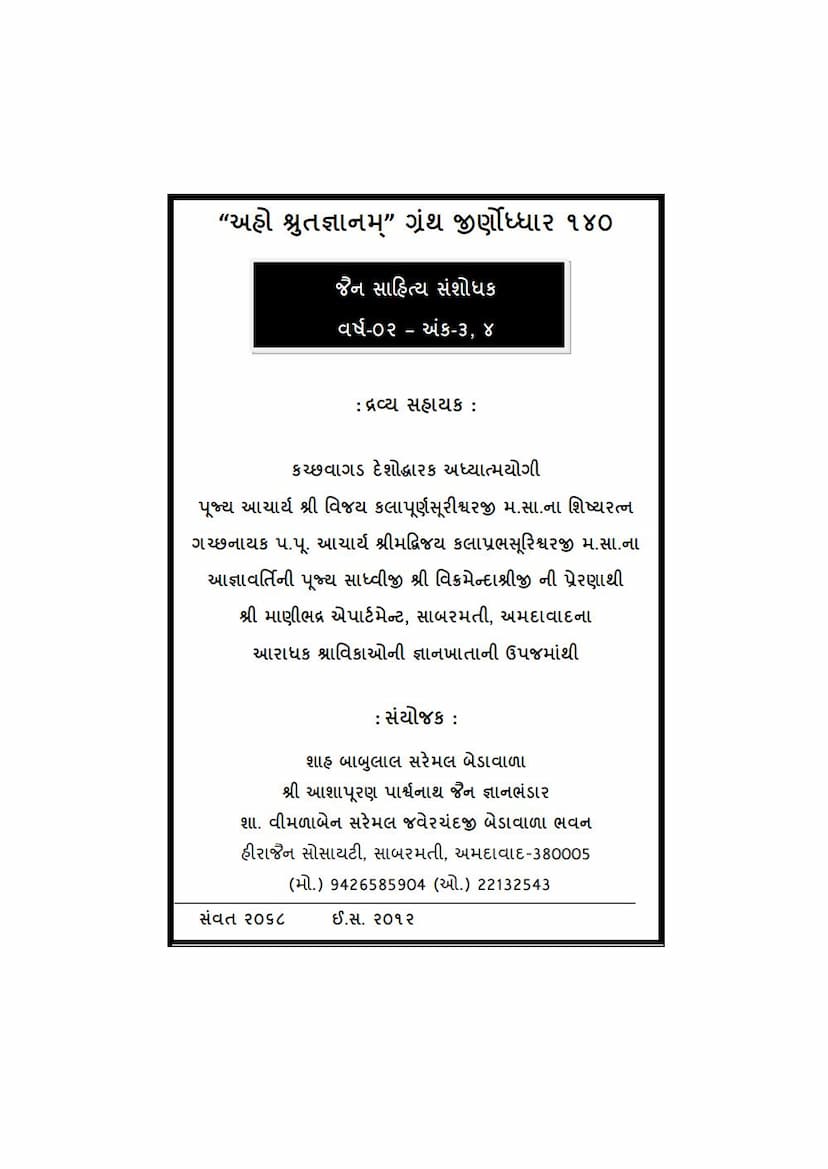Jain Sahitya Sanshodhak Khand 02 Ank 03 To 04
Added to library: September 2, 2025

Summary
This document is the 3rd and 4th issue of the 2nd volume of "Jain Sahitya Sanshodhak" (Jain Literature Research), published in 2012 (Samvat 2068) by the Jain Sahitya Sanshodhak Samaj in Pune. The publication is dedicated to the revival and research of ancient and rare Jain literature.
The volume contains several articles focusing on Jain history, literature, and philosophy. Key articles include:
-
"Mahakavi Pushpadant ke Samay par Vichar" (Thoughts on the Time of Mahakavi Pushpadant) by Babu Hiralaal Jain M.A., LL.B.: This article discusses the life and works of the renowned Jain poet Pushpadant, analyzing his poetry like Mahapurana, Yashodhar Charita, and Nagkumar Charita. It attempts to ascertain his period by referencing his mentions of various scholars and historical events, placing him likely during the reign of the Rashtrakuta king Krishna III.
-
"Kavivar Samaysundar" (The Poet Samaysundar) by Shri Mohanalal Dalichand Desai B.A., LL.B.: This detailed essay explores the life and literary contributions of the Jain poet Samaysundar, who lived in the 17th century. It delves into his extensive work in Gujarati literature, covering his adherence to the Kharatar Gacch tradition, his interactions with Mughal emperors like Akbar, and his prolific writing in various genres, including devotional poetry, narrative poems (rasas), and philosophical works. The article highlights Samaysundar's skill in incorporating regional dialects and contemporary social life into his poetry.
-
"Puratatva Sanshodhanano Purva Itihas" (The Pre-history of Archaeological Research): This is an editorial piece or an article discussing the history of archaeological research in India, particularly focusing on the efforts made by the British and later Indian scholars to uncover and understand India's ancient past through inscriptions, manuscripts, and ancient sites. It highlights the challenges faced due to lack of knowledge of ancient scripts and the destruction of historical records, and acknowledges the significant contributions made by scholars like Sir William Jones, Charles Wilkins, H.T. Colebrooke, James Prinsep, Alexander Cunningham, and Indian scholars like Bhagwanlal Indraji and Rajendralal Mitra.
-
"Vaishalinā Gaṇasattāk Rājyanō Nāyak Rājā Cheṭak" (King Chetak, the Leader of the Republic of Vaishali): This article focuses on the prominent Jain figure King Chetak, the maternal uncle of Lord Mahavir. It details his familial connections to the Jain Tirthankara, his alliances with other major kingdoms of ancient India, and his position as a leader of a republican state. It draws primarily from Jain scriptures like the Avasyak Sutra and Kalpa Sutra, and also references Buddhist literature. The article discusses the historical context of Vaishali and Chetak's role within it, as well as the potential similarities and divergences with Buddhist accounts, particularly regarding the destruction of cities and the fate of royalty.
-
"Śrīmerutuṅgāciraviracitā Vicāraśreṇiḥ - Aparanāma - Sthavirāvaliḥ": This section presents excerpts from Merutuṅgācārya's Vicāraśreṇi (also known as Sthavirāvaliḥ), a significant Jain text that chronicles the lineage and history of Jain monks and important events. The excerpts primarily focus on the Jain calendar system, the chronology of Jain Tirthankaras and important monastic figures, and the timelines of various Jain gacchas (sects/lineages). It also touches upon the history of dynasties and rulers relevant to Jain history, particularly in Gujarat and surrounding regions.
-
"Śrī Jinabhadragaṇi Kṣamāśramaṇa Viracitaṁ Jītakalpasūtra Mūlamātra": This part presents the root text of the Jītakalpa Sūtra, attributed to Jinabhadra Kṣamāśramaṇa, a significant Jain scholar. It focuses on the practices and principles of paścitta (penance or atonement) within Jain monasticism, detailing various forms of paścitta and their application in different situations according to Jain principles.
-
"Śrīmad-Śākaṭāyanācārya viracitaṁ Strīmukti-Kevalibukti Prakaraṇayugmam": This section contains two important philosophical discussions by Śākaṭāyanācārya:
- Śrīmukti Prakaraṇam (The Chapter on the Liberation of Women): This discusses the Jain perspective on whether women can achieve liberation (moksha). It explores arguments and counter-arguments, likely concluding in favor of the possibility of female liberation.
- Kevalibukti Prakaraṇam (The Chapter on the Sustenance of the Omniscient): This delves into the concept of how Kevalis (omniscient beings) sustain themselves without physical food, addressing the apparent paradox and providing philosophical explanations from the Jain perspective.
The volume also includes a list of available Jain books for purchase and mentions the patrons and life members supporting the publication. Overall, this issue of "Jain Sahitya Sanshodhak" is a rich compilation of scholarly articles contributing to the understanding and preservation of Jain heritage.